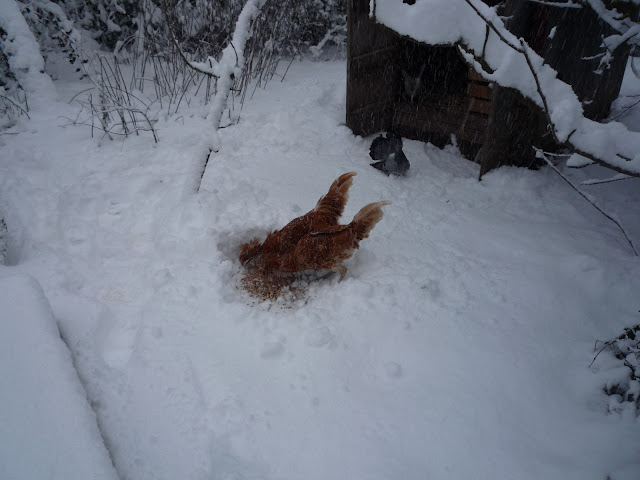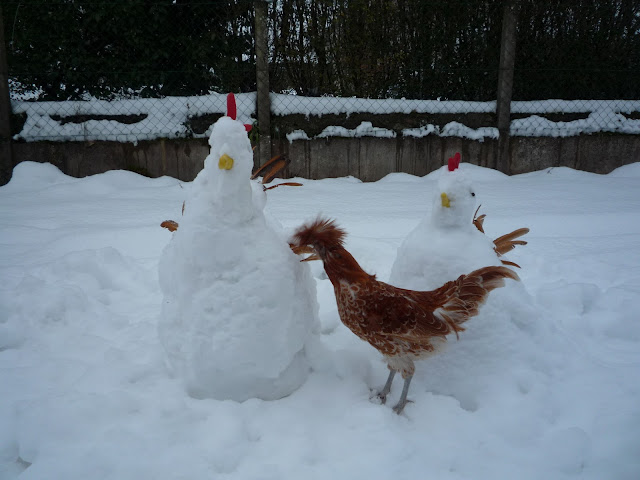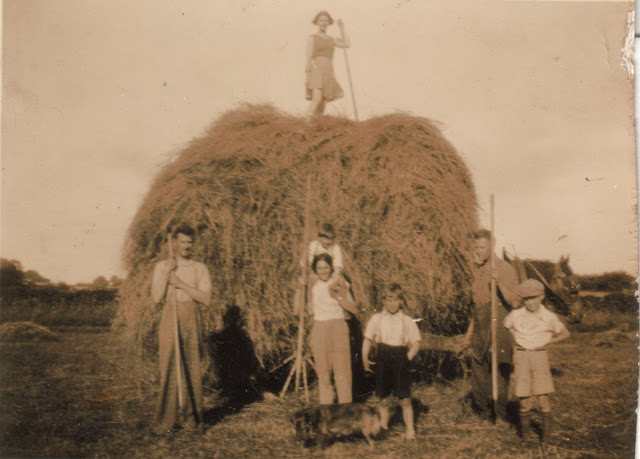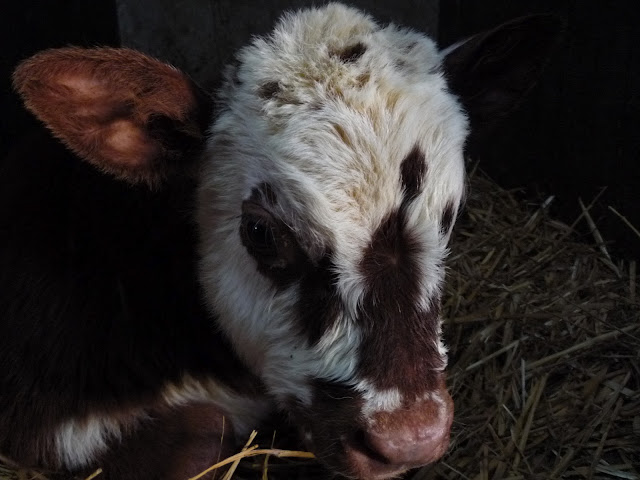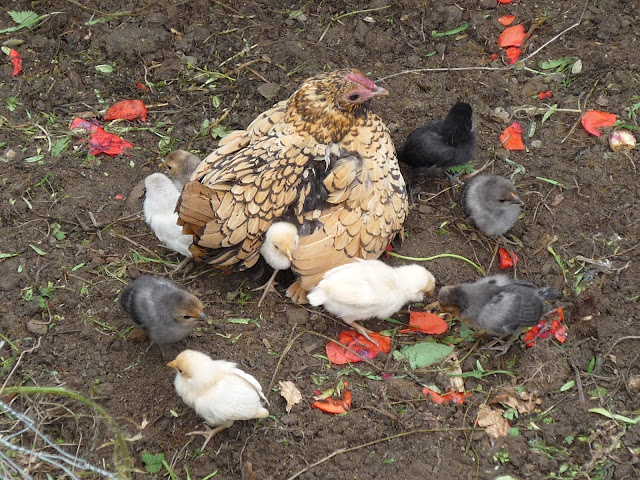Our photographs of the fabulous Polish race of hens, cockerels and chicks below speak for themselves but they have depths of personality and character and above all are so funny, charming and full of surprises that it would take a book to do them justice. Here we have Father and
Sons. White-laced Crested and Bearded Chamois, frizzled Dad (in the
middle) and Black-laced Crested and Bearded Gold, frizzled and
non-frizzled sons. Left to Right:- Rupert, Diavolo and Spike.

I'm starting my advocacy for old breeds, with an in-depth look into the Polish race. They qualify for all the requirements of a true all-rounder, they lay well, eat well, forage well, are reputedly delicious and on top of this are a beautiful addition to any garden. It's hard to believe that a creature which looks so frou-frou can be anything but ornamental and therefore totally unsuited to a backyard or smallholding but in the following article I hope to convince you that they are - and how!
The family portrait above was taken at night in a studio setting, not just because I wanted to show you the gorgeous feathering and shining personality of these birds but for another and far more practical reason. I was worried the brothers and father, living as they do in separate hen houses, though seeing each other daily in the garden, would start to fight. Polish are not aggressive but they do get a trifle silly if brought into unexpected close proximity. In the event, it was the Mother of the family, little Bungle, who started something, hence she was removed for some 'time-out' and did not appear in this picture. The female of the species is not only deadlier than the male but often as in this race the arbiter in disputes. A particular character in the above family is Josephine, Rupert and Spike's adopted Great Aunt (aged 10), who has been known to defend them against others in the flock, usually when they have started something they couldn't finish.

Josephine in one of her quieter afternoon-tea-with-Grandma moments (Bungle, as a chick, on the far left)
The History of The Polish Crested - The stuff of dreams
The legend of the Polish breed is a long and romantic one and one of my favourite episodes is the way in which they arrived here in France. On the 26th of January 1736, Stanislaw Leszczyński, King of Poland, lost his throne for the second and final time and came to France to the court of his son-in-law Louis XV. Packed in the King's luggage were his favourite Polish Crested chickens, who found instant favour amongst the ladies of the court and in particular, with Madame Jeanne Antoinette d'Étiolles, King Louis' then official mistress. So great was her love of them that in France the breed was renamed for her official title and soon became known under the sobriquet of 'poulettes Pompadour'. I can't help thinking that they were also the inspiration for her famous Pompadour hairstyle, which is still as popular today and was the same style made famous in pop culture by Elvis.
Above is the illustration of the Polish cockerel in Ulisse Adrovandi's Ornithologiae, published in Bologna in 1599.

In Italy, where these birds are the main ingredient of several famous traditional Paduan dishes, l
a Gallina Padovana is having a renaissance under the sterling efforts of the Slow Food Movement. The Polish race came to Italy in the Fourteenth Century. They were brought back from Poland by the doctor and astronomer, the Marquis Giovanni Dondi dell'Orologio, who, like Mme de Pompadour centuries later, was struck by their beauty and elegance and described them as "resembling chrysanthemums". The Dondi family were friendly with the Polish royal family so it is probable that the Polish came to Padua through the same route as they were later to arrive in France.
The striking crest on the Polish, which makes them easily identifiable is supported by an actual bony cover, which protects the unusually elongated brain of the breed. The reason for this 'upthrusting' of the brain and why cerebral hernia is associated with crested chickens is still unknown. The other cranial peculiarity of the breed is in the nostrils which are higher and flatter than normal. The tight space between the nostrils and the bone protuberance supporting the crest prevents the normal development of the cock's comb, which is often either completely absent or irregular or knobbly often double and resembling horns, hence Diavolo above! The unique feature of the skull of this breed make it readily identifiable and from evidence of Roman excavations and diggings, it is believed that these birds were already in England at this period.
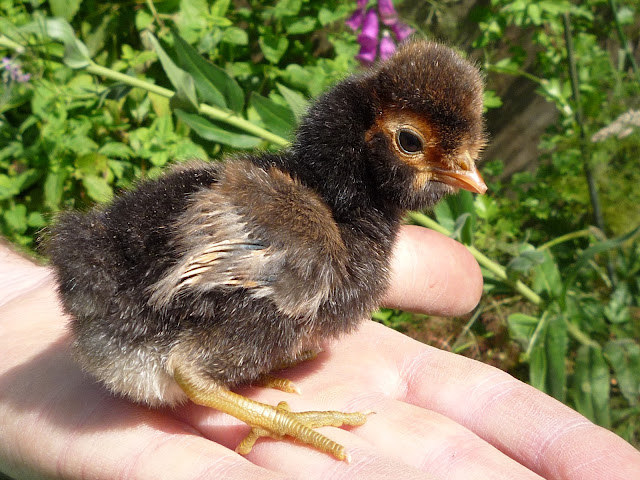
Apropos of this the bony cover which shields the brain, it continues to knit together and harden after hatching, so in the first weeks of life you should take particular care of the chicks. In other words do not place them in any danger of the mother hen jumping down upon them from any height.
Rufus stretching his wings before the first business of the day - Breakfast
You are what your hens eat and so you need them to eat well.

Paradoxically enough, Mrs. Isabella Beeton in her splendid, book of Household Management dated, 1861 (our much-used family copy opposite), shows that even at this date, long before Big Farmer/Big Pharma came into being, the Polish was a most interesting breed from a monetary point of view. I'll take issue however with her on the point of the eggs of the Polish hen being not as nutritious. A hens eggs reflect the hens diet and getting a hen to lay a large amount of eggs needs a large amount of protein in her diet, probably as here in the form of grain, such as triticale or legumes. High protein is not a normal diet for hens, as omnivores and if left to their own devices, they eat a balanced diet and lay fewer, higher quality eggs, with which to produce good strong chicks. The Polish will eat a vast quantity and variety of fruits and vegetables as well as roots, insects, wild grass seeds, various 'weeds', mosses and lichens. I have also seen them eat fungi, minerals and catch and eat small rodents and reptiles.
The Polish are also great at sorting out your compost heap, I use mine to sift through the well-rotted compost, laying it down on a tarpaulin so the chicks can remove woodlice prior to spreading it on the soil. I then leave them to work it into the ground, after which the quail take over to mop up any small nuisances which remain. Of course once the hens have learnt what's inside the bin, they are constantly trying to find ways to storm the battlements.
All weather Polish
 The Polish breed are exceptionally hardy in snow. They are the first out of the hen house, when other hens and cockerels just stand aghast staring at this strange white substance. Not only do the Polish venture forth but they even seem to like eating the snow. Even the young Spring-born chicks have no compunction to play out in the snow and I use the word in its true sense. The Polish breed are one of the few races I have come across where the cockerels actually play tricks on each other. The favourite game which mine enjoy is, taking advantage of the crest obscuring the rear view, the cockerels sneak up on each other and tweak their tail feathers. This makes the victim jump about a metre in the air whilst the others stand around making noises which I can only describe as laughter.
The Polish breed are exceptionally hardy in snow. They are the first out of the hen house, when other hens and cockerels just stand aghast staring at this strange white substance. Not only do the Polish venture forth but they even seem to like eating the snow. Even the young Spring-born chicks have no compunction to play out in the snow and I use the word in its true sense. The Polish breed are one of the few races I have come across where the cockerels actually play tricks on each other. The favourite game which mine enjoy is, taking advantage of the crest obscuring the rear view, the cockerels sneak up on each other and tweak their tail feathers. This makes the victim jump about a metre in the air whilst the others stand around making noises which I can only describe as laughter.
Where to keep Polish
Waiting for the fall - Garbo at apple picking
An orchard is an ideal place for the Polish breed. This doesn't preclude you from keeping them if you don't have one but it provides an environment, where they can be of great help in pest and weed control, find a varied diet and also shade in the hot summer. Polish have very beautiful plumage, thickly upholstered with down under the feathers, like all poultry they are sun worshippers but in the very hot midday sun they are inclined to the shade. We have a walled garden on two sides with high thick hedges on the other two, so our garden can become very hot in Summer, to counter this we planted hedges and shrubs as well as tall leafy perennials. We also grew many trees from seed, such as horse chestnut and eucalyptus which are now mature and providing a good shady canopy. In the orchard, which was a traditional cider apple one, we grafted old eating varieties and I also underplanted with shrubs and roses, scramblers and ramblers. Polish by the way, as do many other hens love petals, particularly apple blossom and roses, usually, happily, they wait until these fall off the tree.
Polish hens don't go broody...
I read this over and over again in websites and even repeated it, albeit with reservations here in this article but the events of last year have made me aware that this is not true. Not just in our garden but from the experiences shared in comments by others when I posted a film about it on Youtube.
I knew Garbo was sitting under the inside a large honeysuckle bush because I heard her snoring one night but I never knew she was serious until I found a tiny chick at the hen house food bowl! Getting them out of the bush and into an orange box to transport them to the house was quite an operation.
So have I convinced you?

Polish hens are not good nest makers and can be careless of where they lay their eggs, at least this first generation was. The cockerels were forever remaking nests and trying to entice the hens to lay in them, only to watch the hen go off and lay in the middle of the garden. The next generation actually make good nests and have even on occasion made attempts to sit (UPDATED see above).
One of the few drawbacks to the Polish is that, due to their being viewed as purely ornamental, they have tended to be over-bred purely for the size of the crest. This can sometimes cause them problems and at one time some years ago there was a strange movement afoot to ban people from keeping them altogether and so would have died out one of the most beautiful, ancient and intelligent breed of poultry. Luckily this move did not succeed and all it needs, if you do come across an overheavy crest in one of your birds, is a careful trim, another good reason to have a good and trusting relationship with your birds. As for the rest, Polish are not great sitters (UPDATED see above) and I am also wary of them in damp weather as like all hens they can suffer from colds and unfortunately as they are ardent foragers they do tend to want to go out in the pouring rain. If you do not have a well planted area where you keep your hens, you would be well advised to make some sort of shelter whereby they can scratch around out of the rain.
What more can I say?
Now if you'd like to, sit back and watch the film:-
Thanks for dropping by and do feel free to share experiences or ask for further information in the comment section. If you have enjoyed this piece and found it useful think about sharing it with your family and friends, on social media and also maybe about joining this blog and/or subscribing to my Youtube, Odysee or BitChute Channel or even supporting us on Patreon or
It all helps to keep me going!
Until next time, all the very best from sunny Normandie!
Sue
RELATED ARTICLES
 Frizzles for a Forest Garden Part 1
Frizzles for a Forest Garden Part 1
In some countries, such as here in France, Frizzles are often viewed as an individual breed rather than a form of feather mutation, which can occur across several races...
read more
Frizzles for a Forest Garden 2 Behaviour & Emotions
Spike is a fine example of a Polish Frizzle and has also something which I believe well illustrates the dilemma faced by the Frizzled bird...
read more The Cochin Craze 1 - A Story of Addiction
The Cochin Craze 1 - A Story of Addiction
These fluffy bundles, which I have been raising for ten years have a unique and fascinatingly terrible history, involving bloody wars, tea, silver and above all opium. A four part article on the chicken version of Tulip Mania and my own Cochin..
read more The Cochin Craze 2. From Craze to Mania
The Cochin Craze 2. From Craze to Mania
'The introduction of these fowls...was a memorable event in the history of poultry; since they undoubtedly awakened a startling "mania" which was, calmly considered, one of the most curious phenomena of the nineteenth century'...
read moreThe Cochin Craze 3. Choosing Cochins for Your Garden
The Cochin like all ancient breeds are excellent foragers and quickly become a vital part of any garden, keeping down weeds and pests. And as not all of the Cochin Craze story was 'spin',..
read moreCochin Craze 4 - Incredible Cochin Mothers & Family Bonds
Cappuccino was with her quail for over 3 months, which gave her so much time with them and for them in turn to appreciate what it was to...
read more

 In Italy, where these birds are the main ingredient of several famous traditional Paduan dishes, la Gallina Padovana is having a renaissance under the sterling efforts of the Slow Food Movement. The Polish race came to Italy in the Fourteenth Century. They were brought back from Poland by the doctor and astronomer, the Marquis Giovanni Dondi dell'Orologio, who, like Mme de Pompadour centuries later, was struck by their beauty and elegance and described them as "resembling chrysanthemums". The Dondi family were friendly with the Polish royal family so it is probable that the Polish came to Padua through the same route as they were later to arrive in France.
In Italy, where these birds are the main ingredient of several famous traditional Paduan dishes, la Gallina Padovana is having a renaissance under the sterling efforts of the Slow Food Movement. The Polish race came to Italy in the Fourteenth Century. They were brought back from Poland by the doctor and astronomer, the Marquis Giovanni Dondi dell'Orologio, who, like Mme de Pompadour centuries later, was struck by their beauty and elegance and described them as "resembling chrysanthemums". The Dondi family were friendly with the Polish royal family so it is probable that the Polish came to Padua through the same route as they were later to arrive in France.
 The Polish breed are exceptionally hardy in snow. They are the first out of the hen house, when other hens and cockerels just stand aghast staring at this strange white substance. Not only do the Polish venture forth but they even seem to like eating the snow. Even the young Spring-born chicks have no compunction to play out in the snow and I use the word in its true sense. The Polish breed are one of the few races I have come across where the cockerels actually play tricks on each other. The favourite game which mine enjoy is, taking advantage of the crest obscuring the rear view, the cockerels sneak up on each other and tweak their tail feathers. This makes the victim jump about a metre in the air whilst the others stand around making noises which I can only describe as laughter.
The Polish breed are exceptionally hardy in snow. They are the first out of the hen house, when other hens and cockerels just stand aghast staring at this strange white substance. Not only do the Polish venture forth but they even seem to like eating the snow. Even the young Spring-born chicks have no compunction to play out in the snow and I use the word in its true sense. The Polish breed are one of the few races I have come across where the cockerels actually play tricks on each other. The favourite game which mine enjoy is, taking advantage of the crest obscuring the rear view, the cockerels sneak up on each other and tweak their tail feathers. This makes the victim jump about a metre in the air whilst the others stand around making noises which I can only describe as laughter.





